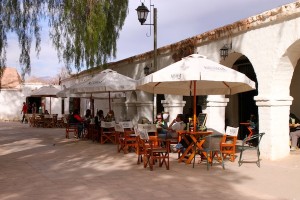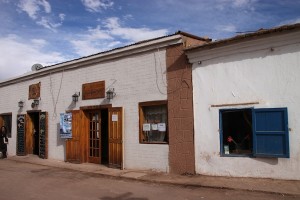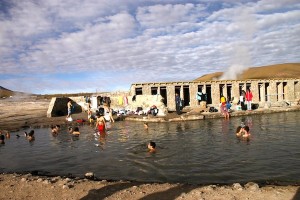I did a lot of research about the Atacama, the world’s driest desert, for my book of travel trivia, but nothing beats seeing the place — which I finally was able to do when visiting Chile in 2012.
My press group saw a wide range of “wondersome” natural attractions as follows, salt flats and their flamingos, volcanoes and a salt mountain range, petroglyphs, saltwater pools (handy for a good float), hot springs, geysers and some incredible scenery.
The latter included a magical sunset seen from the Coyote lookout point above Moon Valley. Stargazing is another attraction, but the skies were cloudy at night when we visited.
I also spent an afternoon strolling in San Pedro de Atacama, the largest oasis with 6,000 residents. The altitude is a bigger number: 8,100 feet.
San Pedro is charming, with a large central square, the 18th century adobe San Pedro Church and streets lined with low-rise, mostly white shops, restaurants and small hotels and hostels. I was struck by the well-designed signage on many establishments. San Pedro also is home to a noted archaeological museum.
The No. 1 Atacama experience (in my view) was seeing some of the 80 or so Tatio Geysers. At more than 14,100 feet above sea level, they are produced when snowmelt flowing underground confronts the hot magma of a volcanic zone, producing steam and a great pressure to escape.
The phenomenon is most impressive at sunrise when hot water hits very cold air, producing dramatically billowing steam.
Our August visit began with a bracing (23F) sunrise walk among the geysers in thin air. We stuck to marked paths (people have gotten too close with fatal results), observing the bubbling hot water at the base of geysers and, of course, the steam. Visitors also took dips in a hot springs on site, but not me!
The desert was a natural for my book, “Travia: The Ultimate Book of Travel Trivia,” because of its amazing characteristics. Some parts of the Atacama have never experienced a recorded rainfall. A key source of moisture is fog, which locals capture in special fog-catcher nets.
However, there are areas where heavy rains occur. Our guide referred to early 2012 flash floods as a “disaster” because they damaged the petroglyphs, for one thing.
The Atacama also is the world’s highest-altitude desert, averaging 13,000 feet, and it includes the world’s highest volcanoes. Given the altitude, this desert is the world’s coldest, too.
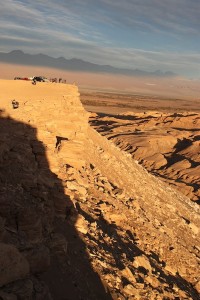
Moon Valley in the Atacama Desert, viewed at sunset from a popular lookout. Another group views the sunset from a lookout visible at far left; the scene indicates the sweeping grandeur of the site.
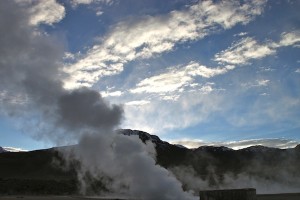
Billowing steam rising to the height of a multistory building before sunrise at the Tatio geyser field.
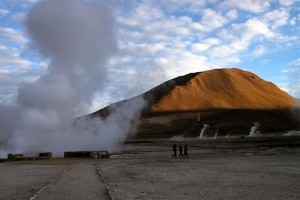
Visitors seen exploring the Tatio geyser field on the Atacama Desert. The steam still rises to great heights, but the sun has begun to show itself.
For more about Chile, we offer at BestTripChoices.com the following, under the headline: A long country https://besttripchoices.com/international-countries/chile/
This blog and photos are by Nadine Godwin, BestTripChoices.com editorial director and contributor to the trade newspaper, Travel Weekly. She also is the author of “Travia: The Ultimate Book of Travel Trivia.”

